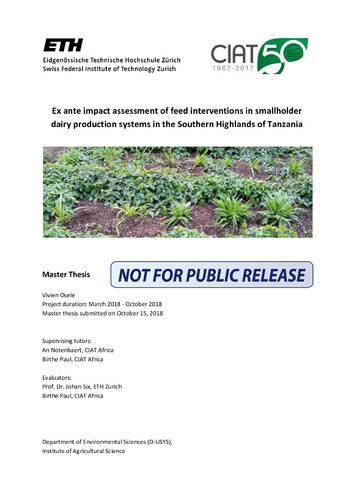Ex-ante impact assessment of feed interventions in smallholder dairy production systems in the Southern Highlands of Tanzania
An increasing demand for animal products has been observed in developing countries due to a high rise in population and increasing buying power. In developing countries such as Tanzania over 70% of meat and milk are generated in mixed crop-livestock systems that provide livelihood for most rural poor people. Simultaneously animal keeping is related to an undesirable environmental impact. Therefore, taking into account both, the positive effects on food security and livelihoods alongside with the potential to minimize environmental impacts, becomes crucial. This thesis focuses on oppor-tunities to sustainably increase livestock production by optimization of quality and quantity of feeds. The project gives insights on how dairy farmers can directly benefit from climate smart feeding op-tions, by enhanced production, while minimizing the negative environmental impacts of production. We focused on 10 case study farms in the Southern Highland of Tanzania. Each farmer was given a selection of improved forage seeds to be planted on their farm. Dairy cow and bio-physical farm per-formance before the introduction of the forages were then compared ex-ante with introduced forag-es scenarios. To quantify impacts of the forage plots on farm level and animal level two models FarmDESIGN and RUMINANT were employed. Through participatory scenario finding with farmers we selected a best bet scenario with a 10% milk increase goal. This scenario was realistic in terms of land allocated for forages and the impact on milk increase was visible especially if forage was pri-marily fed in the dry season. The scenario with 10% milk increase through feeding introduced forages had an overall positive effect on productivity while reducing emission intensity. Introduced forages had an indirect positive impact on income, especially when the new forage plot was planted on un-cultivated land and thus hardly any opportunity costs occurred. Furthermore, time spent for fetching natural grasses in the dry season was reduced. Additionally, the leguminous plants amongst the in-troduced forages promoted an overall increase of nitrogen balance and also GHG emission intensity per liter of milk was reduce by over 5%. We concluded that introducing forages is indeed a feasible way of sustainable intensification, both in terms of environmental efficiency and economic benefits.

